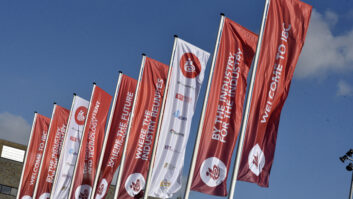
COMM-TEC’s managing director has seen a lot of changes in the marketplace after nearly 20 years at this major European distributor. He talks to Paddy Baker about the challenges involved in maintaining and growing a pan-European distribution portfolio.
How did you start your career in the professional AV industry?
After graduating from university in business studies with a focus on sales & marketing, I went into business working for the export department of WMF, a company that serves hotels and cruise ships worldwide. I did that for four years and joined COMM-TEC, and that’s where I began my time in the pro-AV industry. I started as export manager in 1995. My knowledge of export sales fitted well with COMM-TEC’s pan-European concept.
How do you think the function of a distributor has changed during your time at COMM-TEC?
A key point I should make – from our perspective, COMM-TEC is unique compared to other distributors. We work pan-European, are a value-added distributor but also act as a logistics distributor. We provide all technical expertise, pre and post sales support, training seminars – we do a lot of knowledge transfer to our customers. In providing that, the major change is that the pricing and margins to be earned by the whole chain have been shrinking from year to year. This is a major change for us – we provide a lot of support with shrinking margins.
So your margins are shrinking while the market expects you to add more value. How do you address that contradiction?
For us it’s a matter of selecting which product groups or product segments this value-added distribution model applies to: for us, that’s integration products – it doesn’t apply any more to brands that are sold at a logistic level, like document cameras for example. We differentiate in our company between integration products and fast-moving products.
With our solutions approach, we carry significant brands and portfolio areas that we want to combine as a one-stop offering to dealers, to integrators. It’s a broad line differentiated in four different segments: presentation, conference, signal management and control, and racks and mounts – a large variety of brands and solutions like Barco, BrightSign, Gefen, Vidyo, Televic, ClearOne Mediasite, dnp, Da-Lite and Middle Atlantic Products that we want to put together.
How do you approach adding brands to your portfolio?
Our portfolio covers a lot of the needs of integrators and resellers. We have core brands in these segments, and we always look to improve our portfolio, but the improvement should come from major brands that fit into these segments.
It’s also the case that at COMM-TEC we’ve always had major brands in our portfolio which drove our business and drove the solutions approach. For many years we distributed AMX in certain countries, and today we are heavily involved in collaboration with Barco, with ClickShare and corporate AV projectors – that is a star in our portfolio.
Have you found that other distributors have copied your value-added approach?
Very much. It’s a two-sided thing when it comes to competition. There are distributors who concentrate on pure logistics without the value-add, but some competitors have tried to take the value-added approach. But our situation is quite unique: we work Europe-wide and we have a wide portfolio with different segments. Most of our competitors only have one product segment, and most of them aren’t working Europe-wide – so that’s a big differentiator.
How many countries do you operate in?
We have dedicated operations in Germany, Switzerland, Italy and Spain and even started COMM-TEC Asia in Hong Kong last year. However, that’s not the full answer because in many other European countries we have sales offices with dedicated sales people on site with the local language; logistics, backup supplies, value-add, pre and after sales support are carried out by the head office in Germany. We are adding these country by country – currently we are present in France, the Netherlands, the Czech Republic, Slovakia and Poland. Our export sales managers travel in countries where we don’t have local presence. The UK? That’s a core market with many strong distributors already present, so we don’t have dedicated additional plans for the UK.
What have been the biggest changes for you and for the company over the years?
Entering the pro-AV industry with COMM-TEC was a big change in my business life. I had some big results in new export countries like Austria but also in more remote ones in Eastern Europe. Then the major change obviously came eight years ago when I became a shareholder of the company and also managing director, in charge of all the sales and marketing for COMM-TEC Germany and the countries we cover from here.
For a distributor, the major changes are always changes to the portfolio – for instance going out of AMX and going in with other major brands like Barco – this has been a big transition period. The success of COMM-TEC is always driven by making the best of the portfolio we carry – the best for us and also the best for the manufacturers we represent. There is a long line of manufacturers who are interested in being distributed by ourselves. Many of them are not well known in Europe to the biggest extent, but others are major companies. For us, the decision to include a manufacturer is always dependent on what we already carry in a segment – we’re not keen to put head-to-head competitors in our portfolio.
Mergers and acquisitions have also been a big topic for us in previous years. Big companies acquire smaller ones to get a bigger presence in Europe, or distributors look to buy other companies. In fact COMM-TEC Switzerland was bought like this and renamed afterwards.
Do you have some brands that you only distribute in certain countries because they have other distribution arrangements elsewhere?
This is obviously the case for us – a major point we need to cope with and accept is that our pan-European approach is often not possible with manufacturers any more. If COMM-TEC is interested in distributing a manufacturer throughout Europe, these are generally niche manufacturers, maybe from Asia or the States, who do not have a big European presence. So for these manufacturers it works, but most of the core ones drive a policy of setting up different distributors throughout Europe. This has been a change on the manufacturers’ side – despite Europe having opened up its borders, they work with different distributors in different parts of Europe, choosing the strongest distributors in a pattern of countries that fits together.
Why do the manufacturers do that?
They want to have the best presence and power in dedicated countries. They start with the core ones – UK, France, Germany – then go further into territories like Scandinavia and eastern Europe. If they are a strong manufacturer they already have business in the new countries and they want to make sure that if they work together with a distribution company they have the strongest partner available in those countries.
Some companies do go with one distributor across many countries: in the case of COMM-TEC, we carry Barco ClickShare in Germany, Austria, Switzerland, also Eastern Europe, Italy, Spain – so huge coverage; some manufacturers only work with us in the German-speaking countries and follow other distribution concepts elsewhere.
Also, manufacturers usually don’t jump from having a local presence via six or seven distributors in 15 countries, to just one distributor – that would be too risky a change to make.
COMM-TEC has carried branded products of its own for a few years now. What is the thinking behind that?
It’s for products where the COMM-TEC brand is much better known in Europe than the Asian manufacturer’s name – it’s an OEM approach. The other aspect is that we sometimes identify niche products that are not available with the feature set that we think can be sold – then we draw up a design and a feature set and have the product manufactured by partners. And, to return to portfolio issues, we have exclusivity all around the world on COMM-TEC branded products.
How much has COMM-TEC’s business been affected by AV-IT convergence?
It has changed a lot, and it still changes day by day. In recent years we have had more and more IT system integrators as customers, because we carry products that they need. A good example is ClickShare – it’s a conference room collaboration product, but IT integrators work inside conference rooms so they see the need for these kinds of products. On the other side, we make marketing approaches towards the IT channel, offering solutions and brands that they need.
There has also been a major change among pro-AV integrators: either they have seen the need to embrace IT technology or they have been confronted with it. We have done webinars, seminars, training sessions on IT equipment in pro-AV installations. We have been driven by manufacturers who brought more and more IT products into our portfolio, and we made sure that we were a partner for pro-AV integrators to get the training and the products that they need.
If you could wave a magic wand and change one thing about the industry as a whole, what would it be?
There is no clear certificate needed in the pro-AV industry – almost anyone can open up an integration company and start work. This is not the case with the IT industry – there you need to have certificates to buy certain brands. With the pro-AV industry there are no standards where integration companies need to prove that they are capable of doing things. What InfoComm is doing on certification hasn’t really ended up in the German-speaking market.
It would benefit end users, manufacturers and integrators: often currently the end user is working in good faith with what he thinks is a professional company, and he gives the order to the cheapest bidder without knowing that the project he will get in the end will be different from what he would get from a strong integrator.
Finally, do you have any unfulfilled ambitions – either personal or professional?
The answer is no. The only thing I can say here is I want to make COMM-TEC even bigger and stronger. It’s good already, but I’m aiming to make it better – the ambition is to keep it growing.







